A Job Worth Doing
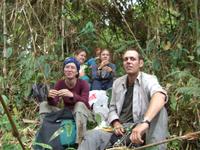 Once again I find myself surrounded by females. It's a trend I've become familiar with: volunteer projects, be they humanitarian or conservation, are dominated by girls. Don't get me wrong, I'm not complaining (far from it) but it does make you wonder why girls are so keen to do their bit and the lads don't seem too interested. I'm sure some psychologist out there would have some deep and profound explanation for this situation but the best I can work out is that guys, in general, just don't give a shit.
Once again I find myself surrounded by females. It's a trend I've become familiar with: volunteer projects, be they humanitarian or conservation, are dominated by girls. Don't get me wrong, I'm not complaining (far from it) but it does make you wonder why girls are so keen to do their bit and the lads don't seem too interested. I'm sure some psychologist out there would have some deep and profound explanation for this situation but the best I can work out is that guys, in general, just don't give a shit.It has to be said however, that the few guys who do involve themselves in these projects are seriously dedicated when they do. Take Dave for instance, the only other male westerner that I work with in my stint here. Dave's the research assistant on this bear project. He's a young, English zoologist who has been working here for the last year and a half, six to seven days a week for a wage close to nothing. He pretty much runs the day to day aspects of the field work, allowing Armando to focus on the promotions, politics and paperwork back in Quito.
One of Dave's many jobs is to coordinate us volunteers (i.e. myself and my harem of ladies). I guess I should explain a little about the Andean Bear (which I have now seen, but only in the rehabilitation center - more on that in the next blog) and what it is we actually do out here, since “bear tracking” isn't exactly dinner table talk in most homes. The work is both more and less than what I was expecting when I signed up so I imagine it is some way from what you would expect as well.
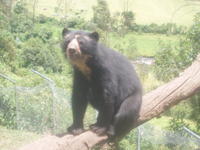 The Andean Bear is a little different than you might imagine (assuming you, like me, grew up watching Yogi Bear cartoons and re-runs of Daniel Boon). The Andean bear, found only in South America, is a good bit smaller than the more familiar Brown Bear. They have a physique similar to a large German Sheppard on steroids. They are black and fluffy looking (almost cuddly) with patches of bright white. Often these patches form rings around the eyes that look a little like goggles, which is why they are sometimes given the nickname of Spectacled Bears.
The Andean Bear is a little different than you might imagine (assuming you, like me, grew up watching Yogi Bear cartoons and re-runs of Daniel Boon). The Andean bear, found only in South America, is a good bit smaller than the more familiar Brown Bear. They have a physique similar to a large German Sheppard on steroids. They are black and fluffy looking (almost cuddly) with patches of bright white. Often these patches form rings around the eyes that look a little like goggles, which is why they are sometimes given the nickname of Spectacled Bears.These guys live throughout the Andean mountain ranges. They can be found in just about every patch of remaining cloud forest, from Venezuela in the North, to Chili in the South. They like their solitude and only meet with each other for the occasional shag or fight (or both). Both guys and girls mark trees by rubbing off moss with their backs and then scratching them with their claws. It's believed this is a little like a personals column, where the bears leave comments about their stature and prowess. If you could read bear then a marked tree might say something like: “Large male with strong claws seeks female with shiny coat for long mountain walks and the occasional corn dinner.”
 Personality wise, the Andean Bear is more like the Panda than the more aggressive Brown and Black Bears. They are extremely shy and are only ever seen during corn season, when they occasionally leave the safety of the forests to snack on corn-treats, unwillingly provided by local farmers. They are vegetarians by choice, eating mostly bamboo, bromeliads (large forest flowers that grow in tree branches) and berries when they can find them.
Personality wise, the Andean Bear is more like the Panda than the more aggressive Brown and Black Bears. They are extremely shy and are only ever seen during corn season, when they occasionally leave the safety of the forests to snack on corn-treats, unwillingly provided by local farmers. They are vegetarians by choice, eating mostly bamboo, bromeliads (large forest flowers that grow in tree branches) and berries when they can find them.When forced to it by a lack of food, they will eat meat (domesticated animals such as cows, sheep, and chicken make easier targets than savvy forest animals) though they are useless hunters, relying on brute strength rather than skill. When attacking a cow, for instance, they go for the back, rather than the throat like natural predators would. The cow dies a slow and painful death and quite often is still alive when the bear drags it back through the forest to a safe eating spot. Usually the cow will die, not from the wounds inflicted by the bear, but by having its head smacked against every tree on the way, breaking its neck.
The Andean bear does share one attribute with the other bear specie however: they're dying. Humans are steadily advancing into the homelands of these shy creatures. Little by little, the lush, green forests are being replaced by cultivated fields and small villages as the ever growing hoard of humanity looks for new ways to feed and support itself.
The bears are forced to retreat further and further into the hills. Those that don't, those that instead stay near human settlements, eating crops and livestock are quickly hunted down and killed as pests (this is illegal, but rarely enforced). No one knows exactly how many bears are left but it is certain that if the “progress” of man continues there will soon be none left to count.
 It's here obviously that this conservation project comes into the picture. Our mission is nothing less than to save the Andean Bear from extinction. Since saving the Andean Bear can only be achieved by preserving as much cloud forest as possible, this goal has many fringe benefits. Not least of these is the preservation of the human race. Despite our stubborn reluctance to concede the obvious, there is no way for humans to live without the air, food and materials provided directly or indirectly by natural forests.
It's here obviously that this conservation project comes into the picture. Our mission is nothing less than to save the Andean Bear from extinction. Since saving the Andean Bear can only be achieved by preserving as much cloud forest as possible, this goal has many fringe benefits. Not least of these is the preservation of the human race. Despite our stubborn reluctance to concede the obvious, there is no way for humans to live without the air, food and materials provided directly or indirectly by natural forests.The most important step towards conserving the Andean Bear is understanding their needs and their behaviors. So little information is known about these bears that any plans in place for their protection are currently based on guess work. Our main focus is to monitor the movements and activities of specific bears and from that determine the amount and type of land needed for bears to live and propagate.
As an example of the current level of understanding we have, only a few years ago scientists believed that the Andean Bear was nocturnal. This project now has over five years of data proving that they are active only in the day (with the occasional nap of course) and sleep right through the night. If such a simple and fundamental fact was unknown, imagine how much more we need to learn before we can understand how best to preserve them.
 Tracking bears is not easy. We use radio equipment to home in on a small signal emitted by a radio collar attached to our study bears. Each bear transmits on a different radio frequency and the signal is a short beep (fast if the bear is moving, slow if it's resting). We move along trails, listening at set points for the strongest signal (an error prone system at best since it depends on the human ear) and then take a compass bearing. Based on a days worth of readings it is possible to find where the bearings intersect and as a result narrow down the rough location of each bear (to the nearest patch of forest anyway).
Tracking bears is not easy. We use radio equipment to home in on a small signal emitted by a radio collar attached to our study bears. Each bear transmits on a different radio frequency and the signal is a short beep (fast if the bear is moving, slow if it's resting). We move along trails, listening at set points for the strongest signal (an error prone system at best since it depends on the human ear) and then take a compass bearing. Based on a days worth of readings it is possible to find where the bearings intersect and as a result narrow down the rough location of each bear (to the nearest patch of forest anyway).Since this project is on a shoe string budget our equipment is rough and primitive. Other bear specie have the luxury of big-dollar sponsors. This little project however, the only one in the world tracking Andean Bear movements by radio telemetry, has to make do with the money left over from volunteer contributions (we pay around $350 a month, to cover our food and accommodation costs, and there is little left once that is taken out) and the occasional donation from zoos and environmental groups. More than once I've listened to both Dave and Armando talk wistfully about the high-tech GPS collars used on Black and Brown Bear projects, and the multi-million dollar budget Chinese Panda project, sponsored by the WWF (the wildlife group, not the wrestling one that is).
The project has had up to nine bears at one time but bears have an inconsiderate habit of taking off their collars (when they lose weight) or selfishly dying on us. We currently have only three bears with collars, two females and a male. The male is called Jaime (pronounced hi-me) and the two females are Poracca and Fiona. Fiona was the name of a previous volunteer who it's rumored carried out some “personal assignments” for Armando. For the willing volunteer, it appears that there is a simple way to have a bear named after you.
 Catching a bear to put a collar on it is even more difficult than tracking them. We have several cages up in the forests. These are made from several sheets of solid steel and carrying them deep into the forest is a difficult task (one I've not had to do yet, but may do soon).
Catching a bear to put a collar on it is even more difficult than tracking them. We have several cages up in the forests. These are made from several sheets of solid steel and carrying them deep into the forest is a difficult task (one I've not had to do yet, but may do soon).The cage is fitted with bait (usually a cow's leg, which the bears go for more out of curiosity than hunger), which is attached to a trigger. When the bait is pulled, the door slams shut trapping the bear in the cage. A radio transmitter on the cage is activated and we listen for this signal every morning and night. Should we get an active signal then we would, as quickly as possible, hike into the hills to the cage, drug the bear, take blood and tissue samples, fit the bear with one of our collars and then set it free again.
This method is slow and by no means perfect. The project catches about one bear every six months, and although we check our cages every day there has not yet been a capture in my time here. There is a plan to use dogs to hunt bears and then capture them with a tranquilizer gun. We would be able to catch a lot more bears this way, however realizing this plan on such a tight budget with so few full time staff is a mission in itself.
Most of the work we do is simply hiking and listening. Each morning we set off, often in two groups (a couple of people with Dave and a couple of people with Alberto) along different paths through the forest. Our route changes every day depending on where the bears have moved to. Some walks are challenging (though nothing compared to my first hikes around Buenas Aires) and some walks are casual. Sometimes we walk along dusty roads, through quaint little villages. Other times we disappear high into the mountains, surrounded by nothing but lush green trees and fields of bamboo.
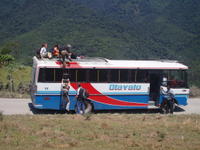 Often we need to catch a bus to the start of a trail. The bus rides are an adventure in themselves as they are usually jammed packed with people heading to the big town of Otavalo. When the buses are full we ride on the roof with whatever goods are being transported (anything from bails of hay, to buckets of blackberries and even the occasional tussled chicken or puppy). We cling to whatever we can, ducking low hanging branches, as the bus hurtles around dusty, mountain roads.
Often we need to catch a bus to the start of a trail. The bus rides are an adventure in themselves as they are usually jammed packed with people heading to the big town of Otavalo. When the buses are full we ride on the roof with whatever goods are being transported (anything from bails of hay, to buckets of blackberries and even the occasional tussled chicken or puppy). We cling to whatever we can, ducking low hanging branches, as the bus hurtles around dusty, mountain roads.If the bears move to previously unused areas (an exciting event as it means our home ranges have been extended) then we occasionally need to make new listening trails. Dave and I spent several days clearing an abandoned and overgrown farmer's trail. At first I felt a little guilty about hacking down swathes of bamboo with my machete. The satisfying feeling of slicing through a ten meter high bamboo stalk and watching it topple to the ground felt a little un-conservational.
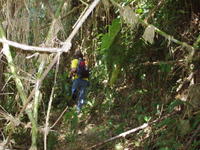 After Dave explained that the bamboo was in fact a fast growing weed that had taken over since the larger, slower growing trees had all been logged, bamboo chopping took on a whole new joy. Clearing away this strangling weed gave the real trees a chance to grow back. I set to, attacking clumps of bamboo with a kind of holy frenzy. I was now wielding the mighty sword of justice, bringing death to the unholy grass of Satan. I may have taken it too far though when I started screaming “die infidel” as I swung my machete and it was only when I noticed strange looks from Dave that I realised I'd said this out loud.
After Dave explained that the bamboo was in fact a fast growing weed that had taken over since the larger, slower growing trees had all been logged, bamboo chopping took on a whole new joy. Clearing away this strangling weed gave the real trees a chance to grow back. I set to, attacking clumps of bamboo with a kind of holy frenzy. I was now wielding the mighty sword of justice, bringing death to the unholy grass of Satan. I may have taken it too far though when I started screaming “die infidel” as I swung my machete and it was only when I noticed strange looks from Dave that I realised I'd said this out loud.Though we work hard, there is time for play on this project as well. Our evenings are usually spent in the volunteer house. It's a simple but comfortable little place with all the basics, including electricity and running water (though only cold showers). It sits on the top of a hill, surrounded by small farms and tranquil views of forested mountains. Some nights we play cards, some nights we watch a DVD on a beat up old laptop, and some nights we lie around in the hammocks drinking rum, staring up at the stars, and swapping tales.
It's fiesta season and nearly every weekend some almost non-existent village is hosting a party. We head down to a few of these and are always welcomed by the locals (the girls get a particularly friendly welcome). The locals share their sickly-sweet fruit wines and rancid sugar-rum (called Puro) with us, until we can handle no more. Each fiesta has a requisite beauty contest. These go on for hours but eventually some local teenage girl is crowned Queen of the fiesta. Somewhat suspiciously the winner is nearly always a relation of the local mayor or some other prominent community figure. After the coronation, the dancing begins and usually doesn't finish until well after the sun has come up.
 A friendly local woman, called Celia, cooks dinner and breakfast for us. The food is simple but tasty: usually some combination of rice, vegetables and lentils. We rarely eat meat. People in these parts can't afford such luxuries. Celia brings her five year old son, Carlos, and two year old daughter, Maria, to the house each morning and night. Carlos and I are now good mates. We climb trees together, throw rocks at things and kick the football around.
A friendly local woman, called Celia, cooks dinner and breakfast for us. The food is simple but tasty: usually some combination of rice, vegetables and lentils. We rarely eat meat. People in these parts can't afford such luxuries. Celia brings her five year old son, Carlos, and two year old daughter, Maria, to the house each morning and night. Carlos and I are now good mates. We climb trees together, throw rocks at things and kick the football around.Carlos is teaching me Spanish, and since he's five he keeps the vocabulary at exactly the right level. I'm not sure he's worked out why I can't speak Spanish that well. I think he assumes I'm a bit stupid. When he hits a word I don't know he repeats it for me very slowly, pronouncing each syllable, and making me repeat each one until I get it right (though I still have no idea what the word means when we're done).
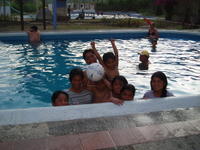 Occasionally, on a Friday evening, we head down to some hot springs for a relaxing soak. There are several pools, all fed by natural spring water and each at a different temperature. After a hard week of hiking and hacking, soaking in some hot water is pure bliss. One weekend we take a bunch of the local kids down and they have the time of their lives running back and forth between the hot and cold pools.
Occasionally, on a Friday evening, we head down to some hot springs for a relaxing soak. There are several pools, all fed by natural spring water and each at a different temperature. After a hard week of hiking and hacking, soaking in some hot water is pure bliss. One weekend we take a bunch of the local kids down and they have the time of their lives running back and forth between the hot and cold pools.As you'd imagine I'm enjoying this project. The idealistic goals and the fact that it is raw and rough enough that someone with a bit of initiative can make a serious impact give me a satisfaction that I rarely feel when I'm working. Within a few weeks of starting I was leading small groups on day trips, and helping train new volunteers. I've decided to stay around for a little while longer as there are several areas where I can help out. This is the worst paying (in fact I have to pay to work) and most challenging job I've had in many a year, but somehow that makes it just a little more satisfying as well.

2 Comments:
Comment by Anonymous, at 1:59 AM
Anonymous, at 1:59 AM
I told you it was all too easy digging holes for me & getting $100/day for the privilege!
Comment by Anonymous, at 8:18 AM
Anonymous, at 8:18 AM
dude sorry but you need to make you webdite a little bit smaller because it took me at least an hour to read it it is a good website i loved it but it was just a little bit to long...